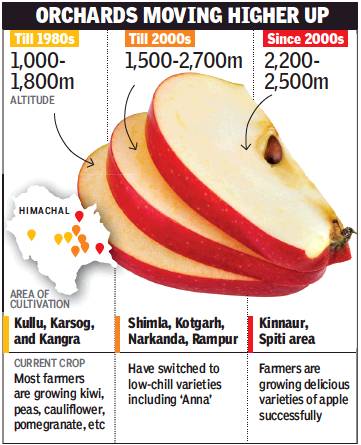Himachal Pradesh: Horticulture
This is a collection of articles archived for the excellence of their content. |
Apples
Orchards are shifting uphill

From: Shilpy Arora, Why apple orchards are shifting uphill in Himachal Pradesh, November 28, 2018: The Times of India
This Kotgarh resident recalls how his family would be busy each year around Diwali, selecting the best apples from their farm and packing them into crates. Business was never a worry in India’s apple bowl — Kotgarh, in fact, also came to be called ‘Sebgarh’, drawing its name and reputation from the scrumptious apples produced by its orchards.
But slowly, Diwali started getting balmier. The Kotgarh winter started to lose its sting and the apple its flavour. The orchards, too, felt the heat as the effects of climate change became more pronounced and visible. Around 10 years ago, Lal Chand realised the family business would no longer be sustainable.
Chand himself is now unemployed. Many of his peers now grow vegetables and mushroom. “I used to earn Rs 10 lakh-15 lakh a year, till 15 years ago. But things changed as summers became warmer and longer and snowfall dropped in winters,” he says. “I had no option but to give up apple farming, which was my passion.”
Located in the temperate region of Himachal, Kotgarh’s entire agricultural land was dominated by apple orchards till the 90s. But as the 90s wore on, this began to change due to erratic weather patterns. Consequently, from Kullu, Shimla (where Kotgarh is) and Mandi districts, cultivation of apples has moved higher up, to Kinnaur, Lahaul and the Spiti valley.
Excess rain and lack of snow make it difficult for apple plants to survive. But a warm climate leads to a loss of fruit-bearing ability, a decrease in the fruit’s size, reduced juice content and change in the colour of apples.
2018: Kinnaur’s output down as honeybee count thins
Statistics show apple production in Kinnaur district has increased 4.8% in the last 10 years. The area under cultivation has gone up twofold, from 8,830 hectares to 12,430 hectares.
But speak to any farmer and you’ll hear production in each farm is going down with the increase a reflection of more orchards being set up, not the productivity. A key reason is failure of pollination due to a fall in the bee population, with human intervention largely to blame. Honeybees are key pollen carriers as they can work for longer hours, and adapt to various climatic conditions.